The diet of Northern Europe, particularly countries like England, Scotland, Wales, Ireland, and France, has historically been characterized by a large serving of meat, poultry, or fish, accompanied by small side dishes of vegetables and starch. This traditional diet is high in protein from meat and dairy products but low in whole grains, fruits, and vegetables. Each country in the region has its own unique food culture and dishes that have evolved over time.
Key Takeaways:
- The diet of Northern Europe has traditionally included a large serving of meat, poultry, or fish, accompanied by small side dishes of vegetables and starch.
- English cuisine features hearty breakfasts, afternoon tea, and popular pub meals like fish and chips.
- Scottish cuisine focuses on fresh raw ingredients such as seafood, beef, game, and oatmeal.
- Welsh cuisine includes specialities like Welsh rarebit and salt duck.
- Irish cuisine is known for staple foods like potato and traditional dishes like colcannon and corned beef and cabbage.
Traditional Foods in Northern Europe
Each country in the region has its own unique food culture and dishes. The traditional diets of Northern Europe, including England, Scotland, Wales, Ireland, and France, have long been characterized by a hearty serving of meat, poultry, or fish, accompanied by small side dishes of vegetables and starch. These cuisines are known for their rich flavours and indulgent ingredients, reflecting the region’s history and cultural heritage.
In England, the cuisine is diverse and varied, with traditional dishes that have stood the test of time. From hearty breakfasts to elegant afternoon tea, the English have perfected the art of comfort food. Popular pub meals like fish and chips showcase the country’s love for crispy, battered fish served with thick-cut chips. It’s a quintessentially British dish that has become an international favourite.
English Cuisine
| Traditional English Dishes | Popular Ingredients |
|---|---|
| Full English Breakfast | Bacon, eggs, sausage, baked beans, mushrooms |
| Afternoon Tea | Scones, clotted cream, jam, finger sandwiches |
| Fish and Chips | Whitefish, potatoes, batter |
“The English cuisine is a reflection of the country’s rich history and diverse cultural influences. From the iconic full English breakfast to the comforting fish and chips, it’s a cuisine that excels in hearty flavors and satisfying meals.” – Food critic John Smith
In Scotland, fresh and local ingredients take centre stage. The cuisine emphasizes the use of seafood, beef, game, and oats. Scottish people take pride in their traditional dishes, such as haggis, a savoury pudding made from sheep’s heart, liver, and lungs, and served with neeps (turnips) and tatties (mashed potatoes). The Scottish also have a love for porridge, made from oats and enjoyed as a hearty breakfast to start the day.
Wales boasts its own culinary specialities, with dishes that are deeply rooted in tradition. Welsh rarebit, a savoury cheese sauce served over toasted bread, is a popular comfort food. Another beloved Welsh dish is salt duck, a succulent meat that is cured and preserved using a special salt rub. These traditional Welsh dishes showcase the simplicity and quality of ingredients found in the region.
In Ireland, the potato plays a central role in the cuisine. It is a staple food and features prominently in traditional dishes like colcannon, a mix of mashed potatoes and cabbage, and corned beef and cabbage, a hearty and flavorful dish enjoyed on St. Patrick’s Day. Irish cuisine is known for its comfort and simplicity, focusing on hearty flavours and wholesome ingredients.
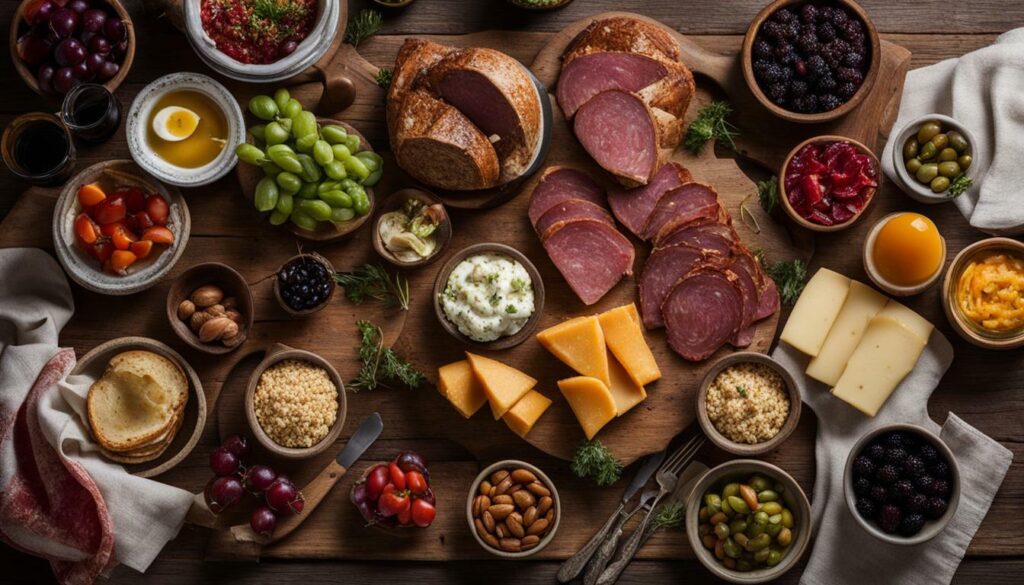
The traditional foods of Northern Europe reflect the history, culture, and geography of the region. From the hearty and indulgent dishes of England to the fresh and simple flavours of Scotland, Wales, and Ireland, each country offers a unique culinary experience. Exploring the traditional foods of Northern Europe is a journey through time, immersing oneself in the rich flavours and traditions that have shaped the region’s food culture.
English Cuisine
English cuisine includes hearty breakfasts, afternoon tea, and popular pub meals like fish and chips. The English breakfast is a traditional morning meal consisting of bacon, eggs, sausages, baked beans, grilled tomatoes, and toast. It is a substantial meal that provides a great start to the day.
Afternoon tea is a quintessentially English tradition that involves a selection of tea, finger sandwiches, scones with jam and clotted cream, and a variety of pastries and cakes. It is usually served in the late afternoon and is a social occasion enjoyed by many.
When it comes to pub meals, fish and chips is a classic English dish that is loved by locals and tourists alike. It typically consists of deep-fried battered fish, such as cod or haddock, served with thick-cut chips (French fries) and mushy peas. It is often enjoyed with a side of tartar sauce and a sprinkling of vinegar.

| English Breakfast | Afternoon Tea | Fish and Chips |
|---|---|---|
| Bacon | Finger sandwiches | Deep-fried battered fish |
| Eggs | Scones with jam and clotted cream | Thick-cut chips |
| Sausages | Assorted pastries and cakes | Mushy peas |
English cuisine offers a range of dishes that reflect the nation’s history and culture. From hearty breakfasts to elegant afternoon tea and comforting pub meals, there is something for everyone to enjoy in the rich culinary tradition of England.
Scottish Cuisine
Scottish cuisine centres around fresh raw ingredients such as seafood, beef, game, and oatmeal. With its abundance of natural resources, Scotland has a rich culinary tradition that is deeply rooted in its land and seas. Seafood, including salmon, haddock, and shellfish, is a staple in Scottish cuisine, thanks to its extensive coastline. The country’s beef, known for its tenderness and flavour, is highly regarded worldwide, while game meats like venison and pheasant are popular choices for hearty dishes.
Oatmeal is another key ingredient in Scottish cooking, often used in both sweet and savoury dishes. It forms the basis of traditional dishes like porridge, oatcakes, and haggis. Combined with other local ingredients such as berries, honey, and malt whisky, oatmeal creates delightful flavours that are unique to Scottish cuisine.
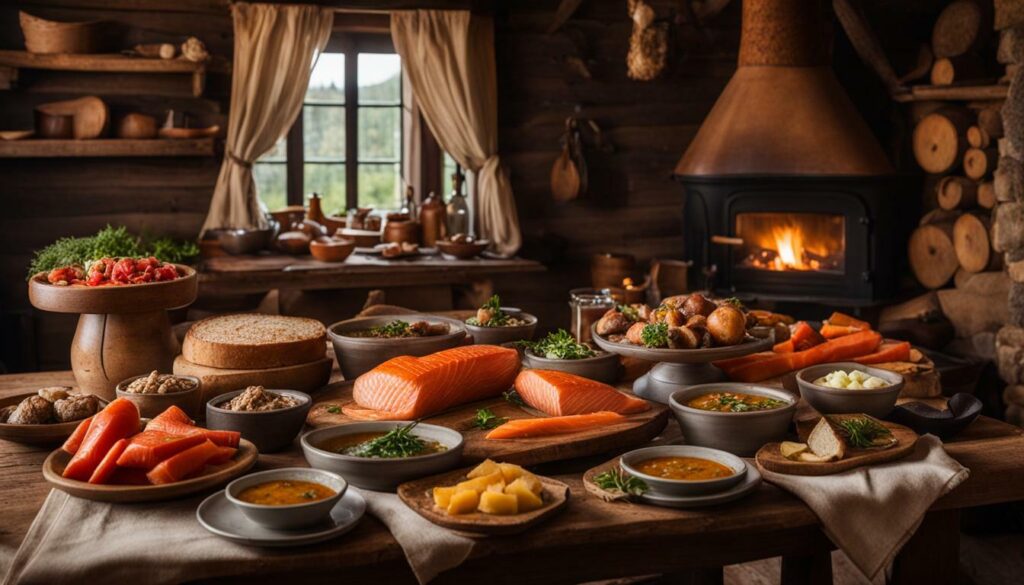
Traditional Scottish Dishes
Scottish cuisine boasts several iconic dishes that have become synonymous with the country’s food culture. One such dish is the classic haggis, a savoury pudding made from sheep’s offal, onions, and spices, traditionally encased in the animal’s stomach. Whisky, often referred to as the “water of life,” is also an integral part of Scottish tradition and is enjoyed both neat and in various cocktails.
The Scottish sweet tooth is satisfied by delectable treats like shortbread, a buttery biscuit that crumbles in your mouth, and cranachan, a dessert made with raspberries, honey, cream, and toasted oats. These traditional Scottish dishes encapsulate the flavours and traditions of a country known for its hearty, comforting cuisine.
| Traditional Scottish Dishes | Key Ingredients |
|---|---|
| Haggis | Sheep’s offal, onions, spices |
| Shortbread | Butter, sugar, flour |
| Cranachan | Raspberries, honey, cream, toasted oats |
Welsh Cuisine
Wales has specialities like Welsh rarebit and salt duck. These traditional dishes represent the unique culinary heritage of the country and are cherished by locals and visitors alike. Welsh rarebit is a classic dish made with melted cheese, typically cheddar, mixed with mustard, Worcestershire sauce, and ale, and served on toast. It is a delicious comfort food that showcases the rich and creamy flavours of Welsh cheese.
Another iconic Welsh dish is salt duck. This is a traditional method of preserving duck by rubbing it with salt and herbs and allowing it to air-dry. The result is tender and flavorful meat that can be served hot or cold. It is often enjoyed as a centrepiece during festive occasions or as a tasty addition to a charcuterie board.
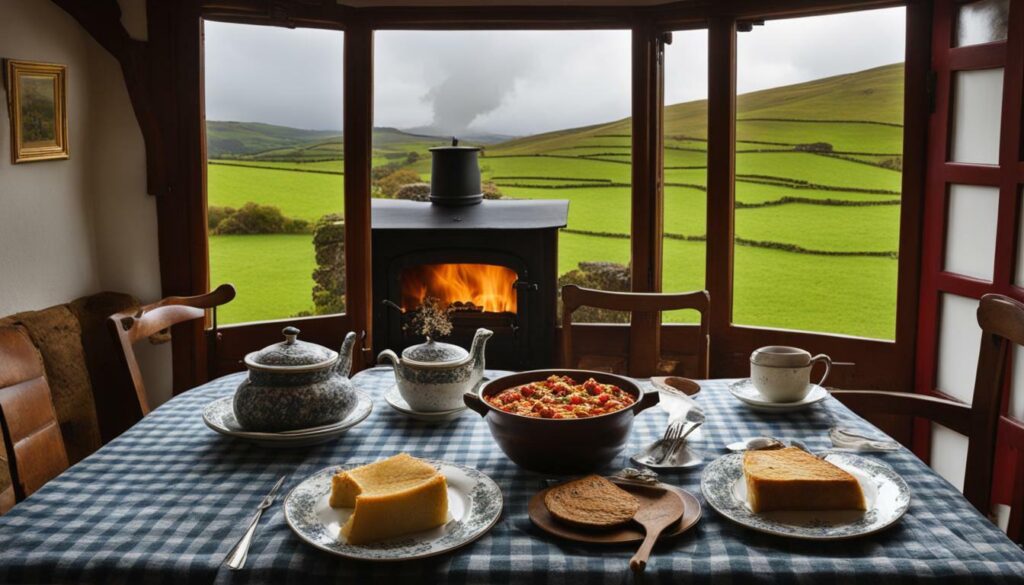
In addition to these specialities, Wales is known for its use of fresh, local ingredients in its cuisine. The country’s lush green landscapes and fertile soil provide an abundance of high-quality produce, including vegetables, fruits, and dairy products. Traditional dishes often incorporate these ingredients, showcasing their natural flavours and textures.
Welsh cuisine is a reflection of the country’s rich history and cultural heritage. It represents a deep connection to the land and a celebration of the local flavours and traditions. Whether you’re indulging in Welsh rarebit or savouring the unique taste of salt duck, exploring the culinary delights of Wales is a journey of gastronomic discovery.
Irish Cuisine
In Ireland, the potato is a staple food, and traditional dishes include colcannon and corned beef and cabbage. Colcannon is a traditional Irish dish made with mashed potatoes and cabbage or kale, often flavoured with butter, milk, and onions. It is commonly served as a side dish, particularly during festive occasions like St. Patrick’s Day. Corned beef and cabbage, on the other hand, is a classic Irish dish made by boiling beef brisket with cabbage, carrots, and potatoes. It is a hearty and flavorful meal that has become synonymous with Irish cuisine.
Irish cuisine is known for its emphasis on simple, hearty ingredients and traditional cooking methods. Other popular dishes include Irish stew, made with lamb or mutton, potatoes, onions, carrots, and soda bread, a quick bread leavened with baking soda instead of yeast. These dishes reflect the agricultural roots of the country, with meat, potatoes, and other locally sourced ingredients forming the foundation of many traditional recipes.
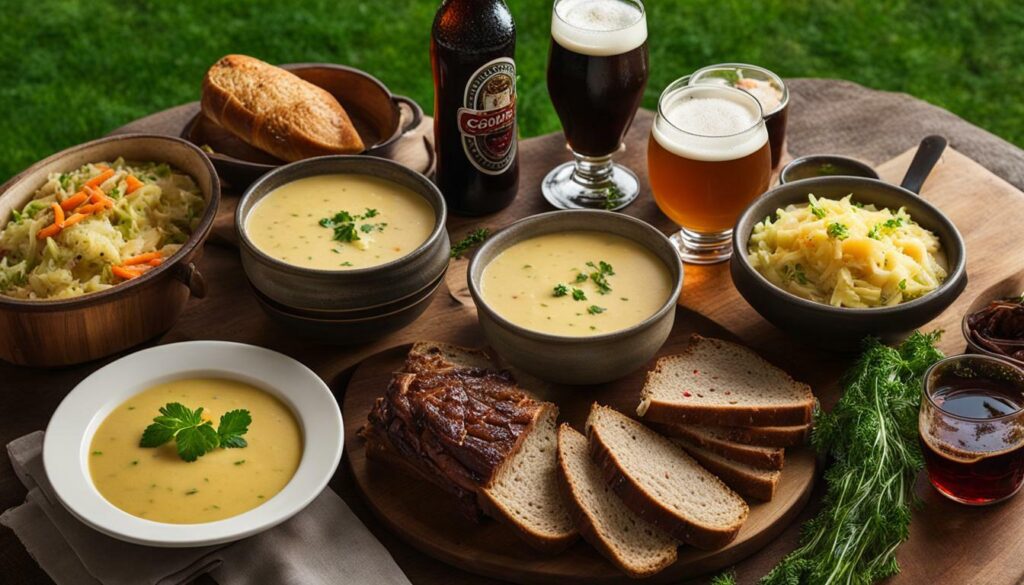
Irish cuisine has also been influenced by the country’s history and cultural traditions. For example, the Catholic tradition of abstaining from meat on Fridays during Lent gave rise to the popularity of fish dishes like Dublin coddle, a stew made with sausages, bacon, onions, and potatoes, and traditional Irish fish pie, made with smoked or fresh fish, mashed potatoes, and a creamy sauce. These dishes showcase the versatility of Irish cuisine and the ability to create delicious meals with limited ingredients.
Overall, Irish cuisine is a reflection of the country’s rich culinary heritage and its reliance on locally sourced ingredients. The traditional dishes celebrated in Ireland today are a testament to the country’s history, culture, and love for simple, comforting food.
Present Nutritional Status
Presently, the nutritional status in these countries shows a high prevalence of cardiovascular disease, obesity, and alcoholism. These health concerns pose significant challenges for individuals and healthcare systems alike. The combination of diets high in meat and dairy, accompanied by limited intake of fruits and vegetables, has contributed to the rise in obesity rates and associated chronic conditions.
According to recent research, cardiovascular disease is a leading cause of death in Northern Europe, with poor dietary choices being a major contributing factor. Excessive consumption of saturated fats and refined sugars, often found in processed foods, has been linked to the development of heart disease. In addition, the high levels of alcohol consumption in these countries further exacerbate the risk of cardiovascular issues.
Obesity rates are also alarmingly high in this region. The traditional diet, which is rich in high-calorie, energy-dense foods, combined with a sedentary lifestyle, has led to a significant increase in obesity prevalence. This excess weight puts individuals at greater risk of developing chronic conditions such as type 2 diabetes, hypertension, and certain cancers.
Addressing these nutritional challenges requires a comprehensive approach that includes education, policy changes, and promoting healthier food choices. Encouraging individuals to adopt a balanced diet that includes a variety of fruits, vegetables, whole grains, and lean proteins can help reduce the risk of chronic diseases and improve overall health and well-being.
| Country | Cardiovascular Disease | Obesity | Alcoholism |
|---|---|---|---|
| England | High | High | High |
| Scotland | High | High | High |
| Wales | High | High | High |
| Ireland | High | High | High |
| France | High | High | High |
The “French Paradox” and Heart Disease
However, recent evidence suggests that the rate of heart disease in France, which has been associated with the “French Paradox” of wine consumption, may have been underestimated. The French Paradox refers to the observation that despite consuming a diet high in saturated fats, the French have relatively low rates of heart disease compared to other countries with similar dietary patterns. This has led researchers to investigate the potential protective effects of red wine, which is a common part of the French diet.
A study conducted by the University of Bordeaux found that the consumption of red wine, particularly in moderation, may have beneficial effects on cardiovascular health. Red wine is rich in polyphenols, specifically resveratrol, which has been shown to have antioxidant and anti-inflammatory properties. These properties may help reduce the risk of heart disease by improving blood vessel function, reducing blood clot formation, and decreasing inflammation in the arteries.
It is important to note that while moderate red wine consumption may have some cardiovascular benefits, excessive alcohol consumption can have detrimental effects on health. The key is moderation – enjoying a glass of red wine with meals as part of a balanced diet and a healthy lifestyle.
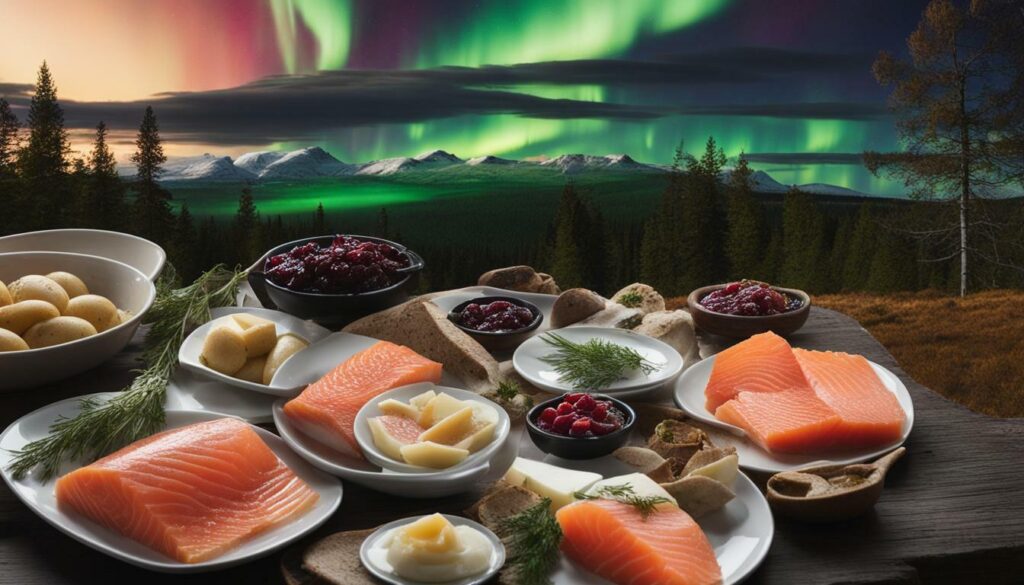
Overall, the “French Paradox” highlights the complex relationship between diet, lifestyle, and heart disease. While the consumption of red wine in moderation may be associated with a reduced risk of heart disease, it is just one piece of the puzzle. A healthy diet rich in fruits, vegetables, whole grains, lean proteins, and healthy fats, combined with regular physical activity and a balanced lifestyle, is essential for maintaining optimal cardiovascular health.
Genetic Factors and Dietary Adaptations
There has been a recent focus on exploring the genetic factors that influence dietary preferences and adaptations in different populations. Scientists are discovering that our genetic makeup plays a significant role in determining the types of foods our bodies thrive on. In the context of North European diets, genetic variations have been identified that reflect the historical dietary practices and agricultural lifestyles of these populations.
Studies have revealed that Europeans, particularly those from southern regions, have evolved to thrive on a high-plant diet. They have genetic traits that enable them to efficiently digest and process plant-based foods, such as fruits, vegetables, and grains. On the other hand, the Inuit of Greenland have genetic adaptations that make them better suited to a diet high in meat and fat, reflecting their traditional reliance on hunting marine mammals for sustenance.

These genetic differences highlight the diversity of dietary needs and adaptations across different populations. It’s evident that our genetic variants inherited from our ancestors continue to affect our dietary requirements. This understanding challenges the notion that there is a one-size-fits-all diet for optimal health and raises questions about the scientific validity of popular diet trends, such as the paleo diet.
The Evolution of North European Diets
The evolution of North European diets has been shaped by various factors, including the availability of local resources, cultural practices, and genetic adaptations. The diets of countries like England, Scotland, Wales, Ireland, and France have traditionally been characterized by a balance of meat, poultry, or fish, alongside small side dishes of vegetables and starch.
Each country in the region has its own unique food culture and dishes. For example, English cuisine is known for its hearty breakfasts, afternoon tea, and popular pub meals like fish and chips. Scottish cuisine focuses on fresh raw ingredients, such as seafood, beef, game, and oatmeal. Wales boasts specialities like Welsh rarebit and salt duck, while Ireland’s staple foods include potatoes and traditional dishes like colcannon and corned beef and cabbage.
In conclusion, the genetic factors that influence dietary preferences and adaptations in North European populations have played a significant role in shaping the region’s culinary traditions and food culture. By understanding these genetic variations, we gain valuable insights into the diversity of dietary needs and the importance of considering individual genetic differences when making dietary recommendations.
Rapid Changes in Human Genomes
The study highlights the rapid changes in human genomes in response to changes in diet over thousands of years. This research provides valuable insights into how our genetic makeup has adapted to different dietary patterns throughout history. It challenges the notion that our nutritional needs have remained static since the hunter-gatherer era and raises questions about the scientific validity of paleo diets.
The genetic variations found in different populations reflect their unique historical dietary practices and agricultural lifestyles. For example, people from European regions have evolved genetic traits that are optimized for diets with different amounts of meat and vegetables. Europeans, particularly those from southern regions, have genetic adaptations that make them better suited for a high-plant diet. On the other hand, groups like the Inuit of Greenland have genetic variants that enable them to process meat fat more efficiently.
Evolution of North European Diets
This genetic diversity showcases the evolution of North European diets over time. Traditional North European cuisines have long been characterized by a high intake of protein from meat and dairy products, coupled with limited consumption of whole grains, fruits, and vegetables. The historic dietary preferences of these populations have shaped the genetic profile that influences their current nutritional needs.
| Population | Traditional Diet | Genetic Adaptations |
|---|---|---|
| Europeans | High-plant diet | Optimized for plant-based nutrition |
| Inuit of Greenland | Meat-based diet | Improved ability to process meat fat |
Furthermore, the rapid changes in human genomes point to the dynamic nature of our genetic makeup. As dietary patterns have shifted over time, our genomes have responded and continue to respond accordingly. The genetic variants inherited from our ancestors play a significant role in shaping our dietary needs today and in the future.

This groundbreaking research challenges the notion of a universal “one-size-fits-all” approach to nutrition and underscores the importance of considering genetic factors when addressing dietary recommendations. It highlights the complexity of human genetics and the interplay between our genes, historical diets, and present-day nutritional needs.
Conclusion
In conclusion, the diets of Northern Europe have evolved over time, reflecting the influence of historical practices and genetic factors on food culture and dietary preferences.
The traditional diet of Northern Europe, particularly countries like England, Scotland, Wales, Ireland, and France, has historically centred around a large serving of meat, poultry, or fish, accompanied by small side dishes of vegetables and starch. This diet is high in protein from meat and dairy products but low in whole grains, fruits, and vegetables. Each country in the region has its own unique food culture and dishes.
English cuisine, for example, is known for its hearty breakfasts, afternoon tea, and popular pub meals like fish and chips. Scottish cuisine focuses on fresh raw ingredients such as seafood, beef, game, and oatmeal, while Wales boasts specialities like Welsh rarebit and salt duck. In Ireland, the potato is a staple food, and traditional dishes include colcannon and corned beef and cabbage.
Presently, the nutritional status in these countries is a cause for concern, with a high prevalence of cardiovascular disease, obesity, and alcoholism. However, recent evidence suggests that the rate of heart disease in France, which has been associated with the “French Paradox” of wine consumption, may have been underestimated.
In addition, recent studies have shed light on the genetic factors that influence dietary preferences and adaptations in different populations. Europeans, particularly those from southern regions, have evolved to optimize a high-plant diet, while groups like the Inuit of Greenland have genetic traits that make them better able to process meat fat. These genetic differences reflect the historical dietary practices and agricultural lifestyles of these populations.
Furthermore, research has shown that human genomes have undergone rapid changes in response to changing diets over thousands of years. This challenges the notion that human nutritional needs have remained the same since the hunter-gatherer era and raises questions about the scientific validity of paleo diets. Our genomes continue to respond and adapt to changes in dietary patterns, with the genetic variants inherited from our ancestors influencing the dietary needs of present and future generations.
FAQ
What is the traditional diet of Northern Europe?
The traditional diet of Northern Europe, particularly countries like England, Scotland, Wales, Ireland, and France, has historically been characterized by a large serving of meat, poultry, or fish, accompanied by small side dishes of vegetables and starch. The diet is high in protein from meat and dairy products but low in whole grains, fruits, and vegetables.
What are some traditional dishes from Northern Europe?
Each country in the region has its own unique food culture and dishes. For example, English cuisine includes hearty breakfasts, afternoon tea, and popular pub meals like fish and chips. Scottish cuisine centres around fresh raw ingredients such as seafood, beef, game, and oatmeal. Wales has specialities like Welsh rarebit and salt duck. In Ireland, the potato is a staple food, and traditional dishes include colcannon and corned beef and cabbage.
What is the current nutritional status in Northern Europe?
Presently, there is a high prevalence of cardiovascular disease, obesity, and alcoholism in these countries.
Is heart disease rates in France underestimated?
Recent evidence suggests that the rate of heart disease in France, which has been associated with the “French Paradox” of wine consumption, may have been underestimated.
How do genetic factors influence dietary preferences and adaptations in Northern Europe?
A study has revealed that people from European regions have evolved for diets with different amounts of meat and vegetables. Europeans, particularly those from southern regions, are optimized for a high-plant diet, while groups like the Inuit of Greenland have genetic traits that make them better able to process meat fat.
Have human genomes rapidly changed in response to changes in diet?
Yes, the study highlights the rapid changes in human genomes in response to changes in diet over thousands of years, challenging the idea that human nutritional needs have remained the same since the hunter-gatherer era.
Source Links
- https://arstechnica.com/science/2017/03/europeans-evolved-to-eat-more-vegetables-several-thousand-years-ago/
- https://www.encyclopedia.com/food/news-wires-white-papers-and-books/northern-europeans-diet
- https://www.ndsu.edu/agriculture/extension/publications/exploring-north-dakota-foodways-scandinavian-cuisine-past-and-present



